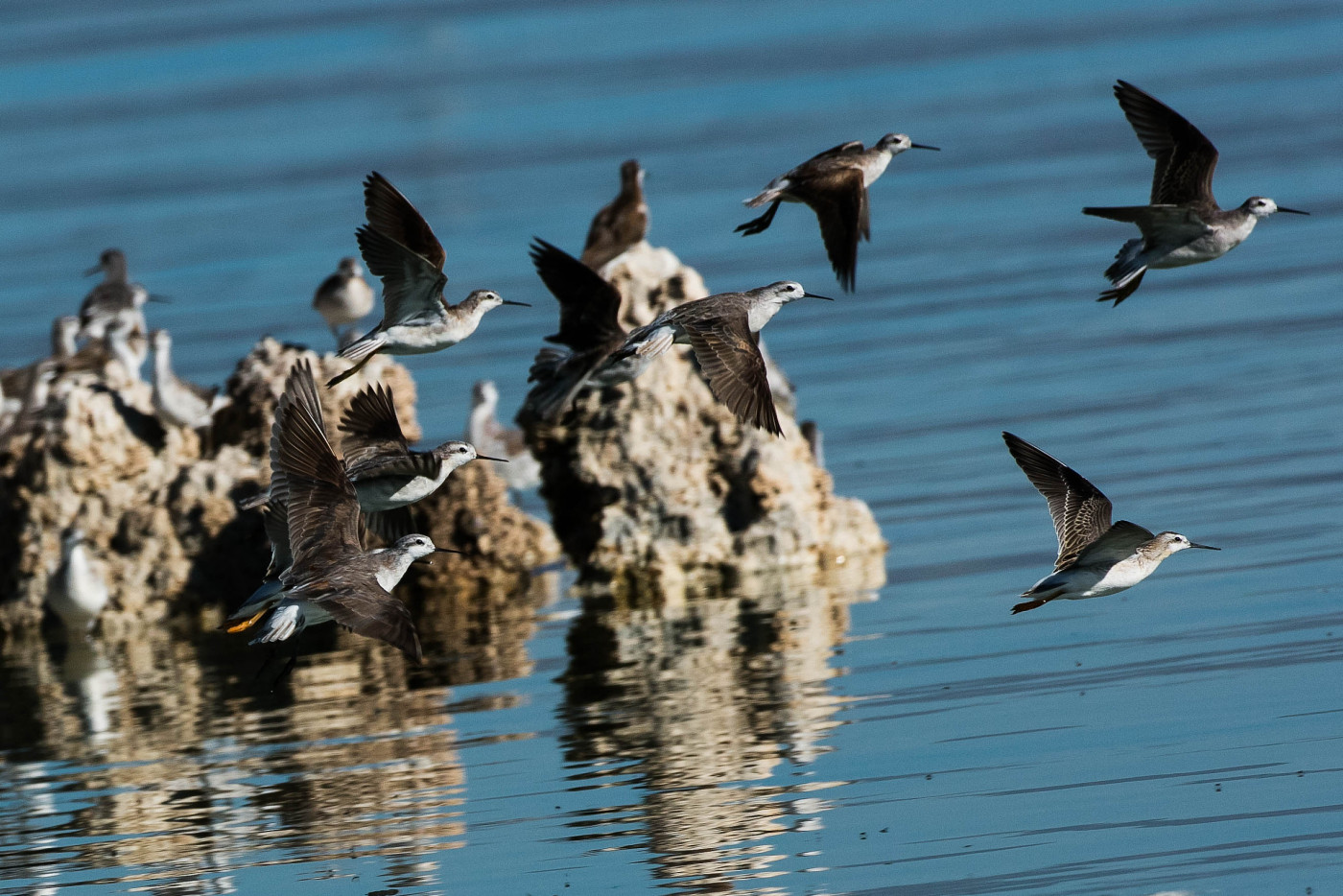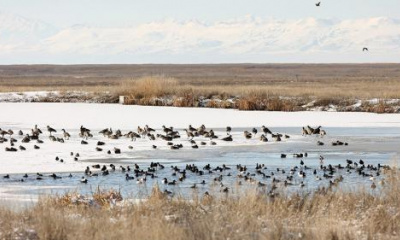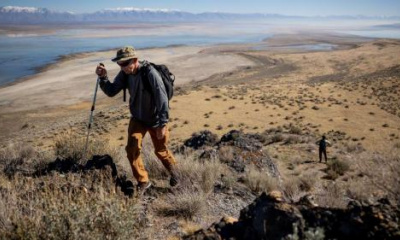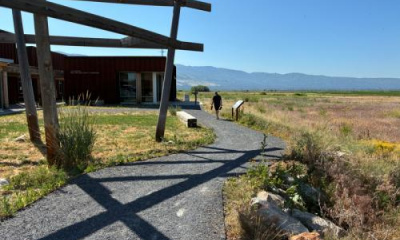SALT LAKE CITY — A conservation group, acting on behalf of a coalition of scientists and other conservation groups, has filed a legal petition seeking to provide new protections for a shorebird species that relies heavily on the Great Salt Lake to survive, which could change how the lake is managed.
The Center for Biological Diversity filed the 119-page petition with the U.S. Fish and Wildlife Service on Thursday, seeking to add new protections for the Wilson's phalarope under the Endangered Species Act. The center emphasized its petition with an extravagant rally on the steps of the Utah Capitol later in the day, which ended in music as people sang about the lake rising again to the tune of "When The Band Comes Marching In."
A few people even dressed as Wilson's phalaropes and danced around the steps in the middle of the song.
"The bird is currently very threatened by the conditions at saline lakes around the western United States, but, in particular, the fate of the Great Salt Lake is the fate of this bird," said Deeda Seed, a senior campaigner for the center, after the event. "If the lake dries up (and) the ecosystem of the lake collapses, we could lose this species. And so an Endangered Species Act listing would confer significant protection upon the bird."
However, Utah Gov. Spencer Cox said he opposes the proposed measure and that the state would "push back" against any possible listing.
Wilson's phalarope and the Great Salt Lake
The species is one of hundreds that make up the Great Salt Lake ecosystem. Wilson's phalaropes make frequent stops at the lake, especially during its annual 3,000- to 4,000-mile migration between Chile and Argentina in South America and the U.S. and Canada. About 40% to 60% of the species' global population is estimated to stop at the Great Salt Lake, Mono Lake in California or Lake Abert in Oregon every year.
The Great Salt Lake is perhaps the most "crucial" way station among these three options, says Ryan Carle, science director of Oikonos, a nonprofit that focuses on "imperiled" ecosystems, who also co-authored the petition after five years of studying the species.
But the bird's population has dropped as saline lakes struggle in the West.
The Great Salt Lake reached an all-time low in 2022, while Lake Mono has also struggled in recent years, and Lake Abert has completely dried up a few times. Carle says about 250,000 phalaropes annually flocked to the Great Salt Lake over the past five years, far lower than the 500,000 to 600,000 counted before the lake's decline.
"There's no replacement for the (three lakes)," he said. "There are no other big salt lakes that have the shrimp and the flies."
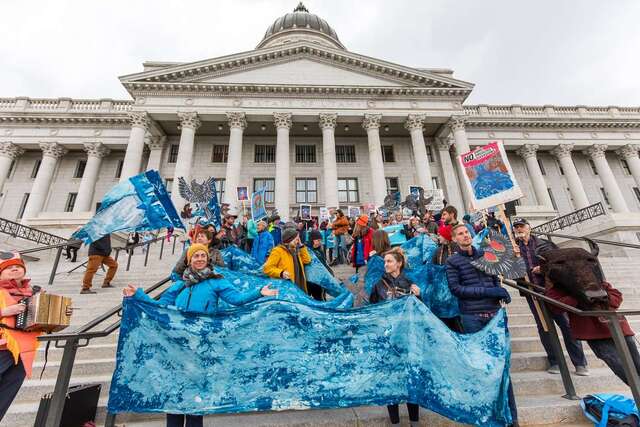
People dress up as different Great Salt Lake creatures and hold signs in support of the lake during a rally celebrating new efforts to protect the Wilson's phalarope at the Utah Capitol on Thursday. (Photo: Carter Williams, KSL.com)
The situation has now gotten to the point where they believe the species needs new protections. However, those behind the effort also believe that the Wilson's phalarope is emblematic of other species that could be threatened if the Great Salt Lake collapses.
They view the Wilson's phalarope as a canary in the coalmine even if it is a shorebird. Its decline indicates that the lake's ecosystem is in trouble. In turn, that troubled ecosystem exposes areas near the lake to toxic dust and other environmental concerns.
"If we allow these birds, their habitat and the Great Salt Lake to disappear, we're endangering life along the Wasatch Front for humans as well," said Dr. Sarah Johnson, a Utah Physicians for Healthy Environment board member. "So while this is a petition to preserve wildlife ... it is also serving to extend preservation to the 2 million-plus inhabitants in this valley."
What the petition does
The paper's authors believe they've made a convincing case for protection in the petition filed Thursday. It triggers a 90-day process where the federal agency will review the petition before determining if the species should be examined further before any protections are handed down.
"We're making a very strong case that this bird is currently very imperiled and needs this protection," Seed said. "At the end of the day, we need to have a healthy ecosystem for this bird. Right now, we don't have that. We've had two good years of water and that has bought us some time, but ... we haven't seen the kind of change that is needed yet."
She added that she wouldn't be surprised if the initial review takes longer because of employee shortages at the Wildlife Service.
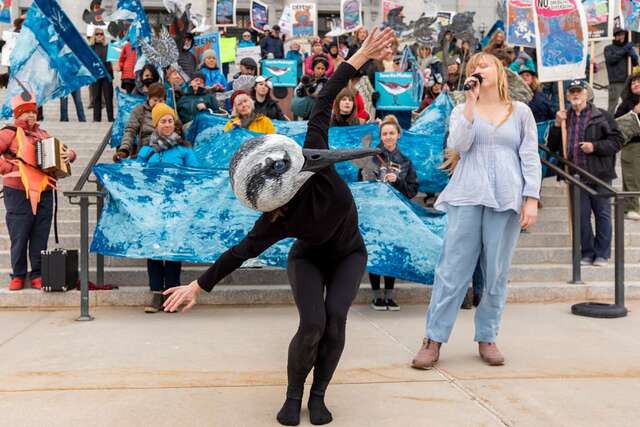
Bryn Watkins, left, performs a dance while wearing a Wilson's phalarope mascot head while Sarah Woodbury, right, sings at a rally celebrating new efforts to protect the species at the Utah Capitol on Thursday. (Photo: Carter Williams, KSL.com)
Meanwhile, the Great Salt Lake has seen some improvements because of the past two winter snowpacks. Its southern arm — home to millions of birds — is above 4,194 feet elevation and expected to exceed 4,195 feet elevation in the coming months, which would be at least 6 feet higher than in 2022. But it's still a few feet below the lake's minimum healthy level, and the lake's northern arm remains at almost 4,191 feet elevation.
Cox pointed to these recent gains as to why he's against the proposed measure.
"We don't think there's any need for a listing there," he said, when asked about it at a different event on Thursday. "We'll definitely push back on any potential listing."
Should the Wildlife Service agree with the petition's findings and then offer protections to the Wilson's phalarope, it could spark a ripple effect for the lake. The federal government would get involved and oversee efforts to save the species, which may spark "federal action" to get more water to the Great Salt Lake, Seed explained.
Ben Abbott, a professor of ecology at BYU, said he believes the state has made large strides in protecting the lake and he also doesn't believe that protections would cause any federal overreach. Instead, he believes it may create "an opportunity" to restore the lake's ecosystem and to ensure it never falls to as low as it did two years ago, posing problems for people who live near the lake.
"I think we need to be very clear-eyed and look for partners everywhere," he said. "Let's keep our eye on the prize. That prize is a healthy lake, a vibrant community and a prosperous and long future in this sacred home."

